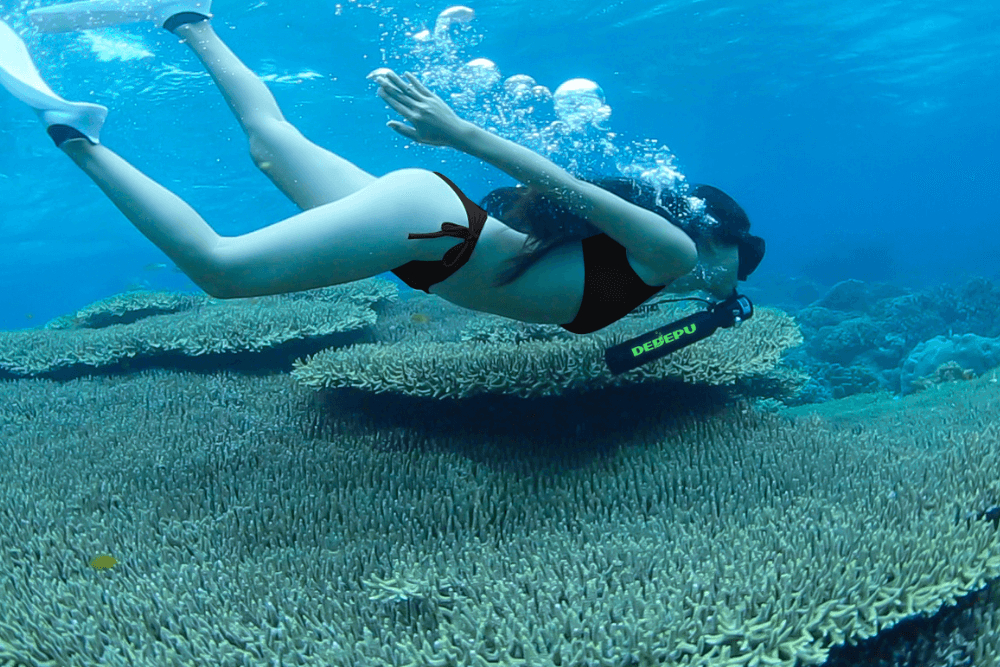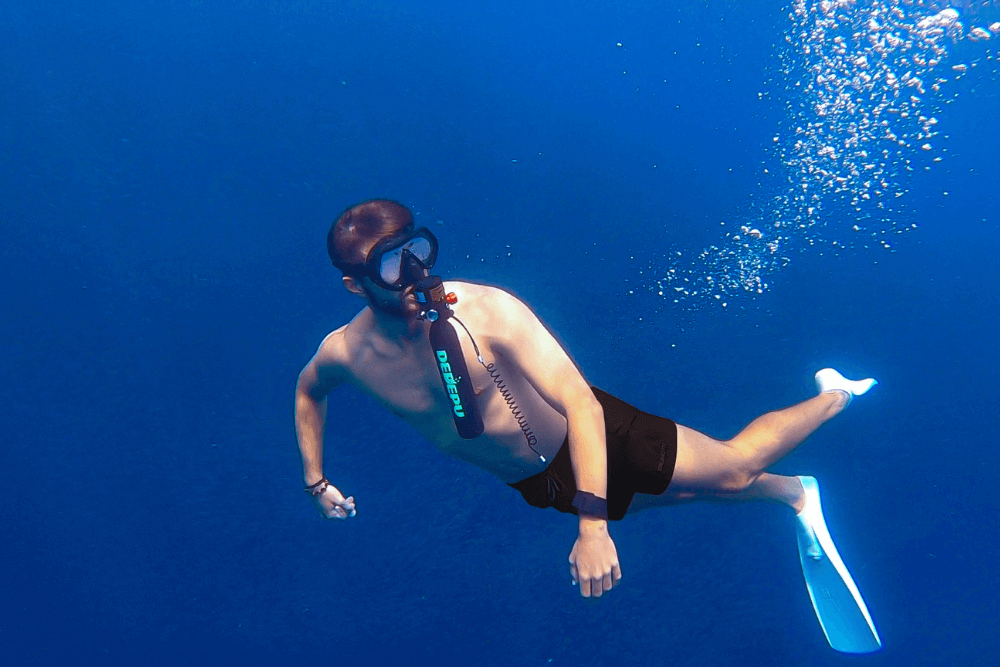The 120 Rule in scuba diving is a simple planning tool used primarily for recreational, multi-dive days at moderate depths. It states: your maximum planned depth (in feet) should not exceed the maximum planned bottom time (in minutes) for any single dive. More practically for consecutive dives: keep the sum of your maximum depth (ft) and bottom time (minutes) below 120 per dive.
For example, a first dive to 60 feet should ideally be limited to 60 minutes bottom time (60 + 60 = 120). If a second dive follows, subtract the number of dives done from 120 to find the new sum limit. For dive two, the limit becomes 119 (120 - 1). So, a second dive to 50 feet could have up to 69 minutes bottom time (50 + 69 = 119). A third dive sum limit would be 118 (120 - 2).
What the 120 Rule Means: The Core Idea
The 120 Rule is a quick mental math tool recreational divers use, mainly for planning repeat dives in a single day within moderate depths. Its core is simple arithmetic: for any single planned dive, your maximum depth in feet plus your planned maximum bottom time in minutes should ideally equal 120 or less. Think of a dive to 60 feet: under this rule, aim for 60 minutes max bottom time (60 + 60 = 120). A dive to shallower 40 feet could plan for up to 80 minutes (40 + 80 = 120). Crucially, it resets for each subsequent dive, getting stricter, using 120 minus the number of completed dives as the new target sum. This isn't a replacement for dive tables or computers but a rough guideline.
So, diving deeper means you must spend significantly less time down there on a single tank, and the 120 Rule provides a specific numerical framework for that balance during planning. If your dive plan calls for exploring a reef at 70 feet deep, the rule suggests your max bottom time should be aimed near 50 minutes (70 feet + 50 minutes = 120). Conversely, if you plan a longer dive focused on observing smaller life, perhaps targeting only 30 feet down, the rule allows you to allocate a maximum of roughly 90 minutes (30 + 90 = 120) assuming you have sufficient air and are diving conservatively within recreational no-decompression limits; this illustrates how the ratio favors much longer bottom times exponentially as depth decreases below approximately 60 feet. The straightforward math is depth (ft) + time (mins) ≤ 120 per individual dive, but its practical use shines for sequential dives – meaning for your second dive of the day, the sum target tightens to 119 (120 - 1), so planning a second dive to 50 feet then implies a max time around 69 minutes (50 + 69 = 119), and a third dive drops the target sum further to 118 (120 - 2), making a third dive to 40 feet feasible for up to about 78 minutes (40 + 78 = 118) before surfacing for the day. This gradual reduction acts as a basic proxy for managing accumulating nitrogen in your body tissue over multiple exposures, acknowledging that even within no-deco limits, each subsequent dive carries a slightly higher inherent risk without adequate surface intervals, though it critically lacks the precision of dive computer algorithms or detailed table tissue compartment modeling tracking dissolved gas over periods often exceeding 120 minutes.

Handling Multiple Dives
The real operational value of the 120 Rule emerges during repeat dives on the same day. It applies a progressive tightening mechanism: the allowable sum of depth (ft) + bottom time (min) decreases by 1 point for each subsequent dive. If your first dive summed to ≤ 120 (e.g., 65 ft + 55 min = 120), the allowable sum for your second dive drops to ≤ 119. A typical second dive target might be 50 ft for 69 minutes (50 + 69 = 119). For a third dive, it tightens further to ≤ 118, perhaps 40 ft for 78 min (40 + 78 = 118). This quantifiable reduction serves as a basic nitrogen exposure counter for sequences of dives often completed within 6 to 8 hours, necessitating surface intervals averaging 60-90 minutes between them.
While the first dive operates within the ≤ 120 sum limit, executing consecutive dives shifts the planning framework: each subsequent dive subtracts the number of previous completed dives from the original 120 benchmark to determine the new allowable sum. Thus, divers start the second dive not at 120, but at an adjusted maximum sum of 119. This forces a tangible reduction; planning a second dive to the same 65 ft depth requires cutting the bottom time from the original 55 minutes down to ≤ 54 minutes (65 + 54 = 119). Alternatively, divers might reduce depth to 50 ft, pairing it with a maximum bottom time of 69 minutes (50 + 69 = 119) – this 19.0% reduction in depth from the first dive enables a potential 25.5% increase in bottom time, illustrating the trade-off relationship and inverse correlation between depth and allowable dive duration under the model. Adding a third dive then requires a further tightening to a maximum sum of ≤ 118. Here, choices narrow: maintaining a 60 ft profile would slash time to ≤ 58 minutes (60 + 58 = 118), a 3.4% reduction from the second dive's 60ft profile, while a move to 40 ft opens the possibility for up to 78 minutes (40 + 78 = 118), representing only a 13.0% depth decrease compared to the second dive but yielding a 13.0% time increase potential.
Critically, surface intervals between dives are mandatory for this rule to have validity; a minimum interval of 60 minutes is often used informally within this model to allow off-gassing. However, actual nitrogen load reduction varies significantly based on previous depth/time exposures, water temperatures fluctuating between 70°F to 85°F (21°C to 29°C), and individual physiology affecting metabolic rates varying by up to 15-20%, meaning the rule provides zero granular accuracy on partial pressure saturation levels. Its practical application rests on using it during pre-dive talks on the boat: "First dive: target 100 total points. Did a 70ft/50min? Okay, second dive now starts at 119 max. Aim for 50ft? Then keep time under 69 minutes max." This sequential subtraction mechanism creates a built-in penalty adding approximately 2-5 minutes less bottom time per dive for equivalent depths in a sequence, imposing a structured operational cadence. However, air supply remains the ultimate daily limiter. A diver consuming air at a high rate of 25 cubic feet per minute (cu ft/min) will deplete an aluminum 80 cu ft tank (~3000 psi fill) down to a 500 psi reserve pressure in roughly 24 minutes at 60ft – less than half the time the 118 sum would theoretically permit at that depth on a third dive, necessitating manual bottom time reduction averaging 30-50% against the rule's target to accommodate individual consumption variances exceeding 50% across populations. Environmental stressors like current speeds reaching 1-2 knots or sudden temperature drops ≥10°F (5.5°C) can cause breathing rates to spike ≥30%, invalidating the time component entirely. Therefore, this adjusted sum serves strictly as a pre-dive planning filter and surface discussion anchor, requiring continuous in-water monitoring of actual air pressure decreasing at ≥ 500 psi increments every 5-10 minutes, along with personal comfort levels fluctuating under ≥ 10-15% physiological load variance. Record actual times and depths at the surface using this framework, then rely completely on computer algorithms tracking nitrogen saturation levels approaching 70-90% of tissue compartment M-values underwater. Attempting a fourth dive under this framework, targeting ≤ 117, pushes risk substantially higher and is generally not advised outside highly controlled conditions with extended surface intervals exceeding 120 minutes and maximum depths kept under 40 ft.
Comparing Dive Tables & Computers to the 120 Rule
Think of the 120 Rule as your quick mental scratchpad – a ±15–20% margin-of-error tool for ballparking dives in benign conditions, whereas formal dive tables like the Recreational Dive Planner (RDP) simulate 16 distinct tissue compartments with half-lives meticulously calibrated between 5-minute fast tissues and 120-minute slow tissues, and dive computers act like underwater flight recorders, processing ambient pressure changes every 0.5 seconds using military-grade sensors (±0.3 ft depth accuracy, ±0.1 PSI resolution) to dynamically recalculate no-stop limits against decompression algorithms accounting for real-time variables like ascent rates exceeding 30 ft/min or thermoclines plunging >8°F (4.4°C) – illustrating why a 60 ft single dive might yield 55 minutes on tables, 65 minutes via adaptive computer logic, yet rigidly 60 minutes under the 120 Rule’s arithmetic.
1. Dive Tables
Recreational dive tables operate through printed tabular rigidity, enforcing safety via depth bands in exact 10 ft increments and no-deco limits defined to 1-minute precision at critical thresholds (e.g., 60–70 ft band: max 55 mins), while explicitly calculating Residual Nitrogen Time (RNT) as a percentage-based penalty – for instance, a first dive to 66 ft (within the 60–70 ft band) for 40 minutes assigns a post-dive pressure group of H, translating to 46 minutes RNT for a second dive at the same depth after a 60-minute surface interval; this compresses the allowable bottom time for the repetitive dive to just 9 minutes (55 max – 46 RNT = 9 mins), a brutal 80% reduction compared to the 120 Rule’s gentle 1-point subtraction (119 sum vs. 120) for the same scenario. Tables further mandate altitude corrections for dives above 1,000 ft (305 m), where atmospheric pressure drops ≥3%, demanding bottom time cuts ≥20% due to reduced off-gassing efficiency, and track tissue saturation across multi-day sequences using 24-hour slow tissue compartments – mechanisms utterly alien to the 120 Rule’s day-limited arithmetic.
2. Dive Computers
Modern dive computers function as microprocessor-driven physiologists, with ultra-low-power chips (<0.1W) sampling pressure, depth, and temperature at 1–2 Hz frequency to feed algorithms like Bühlmann ZHL-16C, which continuously track dissolved nitrogen saturation across 16 virtual tissues, maintaining precision within ±5% of actual tissue tension; this enables adaptive bottom time adjustments mid-dive, such as adding 8 minutes after a slow 25-minute ascent from 80 ft compared to a rapid descent, or slashing limits by 30% upon detecting a cold shock (>10°F drop), correlating to thermal stress studies showing ≤40% faster gas bubble nucleation rates in 55°F (12.8°C) water vs 80°F (26.7°C). Computers dynamically incorporate safety stops at 15–20 ft for 3–5 minutes, reducing venous gas emboli volume by ≥35% compared to direct ascents, and log personal physiological factors such as surface heart rate variability (±10 BPM indicating autonomic stress), and sacrifice tank pressure (PSI/minute) to compute real-time air endurance – features that make the 120 Rule’s static "depth+time" pair resemble blunt cave painting against digital telemetry.
3. 120 Rule’s Gaps
The rule collapses under six critical pressures:
Multi-day dives: It ignores 24-hour tissue desaturation, failing after ≥18-hour intervals where tissues with 120-minute half-lives retain ≥25% nitrogen load, while tables/computers model decay to ≤10%.
Profile variations: A dive oscillating between 40 ft and 80 ft (e.g., reef wall exploration) averages 60 ft depth – the rule inputs 60 ft ignoring the 80 ft spikes generating nitrogen absorption spikes >50% higher than 60 ft equilibrium, whereas computers apply time-weighted averages with exponential gas uptake penalties.
Demographic factors: An overweight 65-year-old diver (BMI >30) experiences ≤15% slower off-gassing and ≤25% higher bubble nucleation rates than a lean 25-year-old – variances algorithms model via conservatism settings (+1 to +3 levels), but the rule treats all bodies identically.
Environmental stressors: In ≥1-knot currents doubling breathing rates to 40 cu ft/min, the rule still permits its calculated time (e.g., 50 ft dive: 69 mins) while air exhaustion occurs in ≤25 mins, and computers actively alert on ascent rate violations (>60 ft/min), inflating DCS probability 300% but unrecognized by the rule’s arithmetic.
Hydration impact: ≥2% dehydration thickens blood viscosity 15%, slowing nitrogen elimination – a risk elevating DCS odds 30% that computers mitigate with dive-light indicators, invisible to 120 calculations.
Altitude dives: At 5,000 ft (1,524 m) where surface pressure drops 19%, the rule’s fixed subtraction system ignores equivalent residual nitrogen pressure multiplying >30%, while tables enforce 40% bottom time cuts.
Contextual Utility vs. Instrumented Truth
Leverage the 120 Rule strictly as a pre-dive group discussion anchor, executing <10-second integer math to scaffold low-complexity 3-dive sequences within recreational limits (<100 ft / 30 m, cumulative sum ≤360 points), but enforce these critical protocols:
Always cap the rule’s suggested bottom time by 25% for actual profiles, reserving ≥500 PSI for safety stops (>15% gas margin).
Cross-verify its outputs against your computer’s displayed no-stop time, assuming it’s authoritative within ±1 minute – if the computer reads 40 mins at 60 ft versus the rule’s 60 mins, obey the device.
Log post-dive depths and times using the rule’s framework for surface review, but rely on computer tissue saturation graphs (>60% loading flags conservative thresholds) for true exposure management.
Discard the rule entirely for dives exceeding 80 ft (where narcosis impairment doubles every 33 ft beyond 100 ft), altitudes >1,000 ft, or multi-day charters requiring slow tissue clearance intervals spanning 48+ hours.
Reality check: A safety buffer exists only if you monitor instruments first – the rule is arithmetic theater without them.

Putting the Rule into Action
On the dive boat rolling through 2–4 ft swells at 8 knots, the 120 Rule transforms from theory to tactical briefing shorthand. Dive masters sketch a three-dive sequence: First dive: House Reef @ max 70 ft for 50 mins (70+50=120), surface interval ≥60 mins eating lunch. Second dive: Canyon @ 55 ft for ≤64 mins (120–1=119 sum; 55+64=119), surface interval ≥75 mins. Third dive: Wall @ 40 ft for ≤78 mins (120–2=118; 40+78=118). This 5-second arithmetic (faster than booting a computer) sets rough boundaries before checking tank fills at 3,000±100 PSI against air consumption rates averaging 20–25 cu ft/min.
Operational Workflow: From Surface to Depth
Initiate planning during the pre-dive briefing (5–7 mins duration) by assigning each diver a personal target sum (120 for dive 1, 119 for dive 2, 118 for dive 3), then calculate max depth/time pairs collaboratively—for a 35-year-old diver with logged SAC rate of 18 cu ft/min carrying an aluminum 80 cu ft tank (77.4 cu ft usable gas), a first dive to 60 ft permits ≤60 mins by the rule, but actual gas constraints limit bottom time to 49 mins at that depth (usable gas ÷ depth consumption: 77.4 ÷ 1.58 cu ft/min ATM = 49 mins), forcing a 20% time reduction against the rule’s theoretical ceiling. Submerged, conduct pressure checks every ≤15 minutes (e.g., starting 3,000 PSI → 2,200 PSI @15 mins → 1,400 PSI @30 mins → 600 PSI @45 mins), and if surfacing with >500 PSI and dive time <90% of rule target, adjust the next dive sum downward proactively by 1–2 points to conserve nitrogen load margin for unplanned currents ≥0.8 knots increasing gas usage 30%.
Between dives, the clock management discipline matters: a minimum 60-minute surface interval is mandated to leverage peak off-gassing within 30–45 mins, where ~40% of residual nitrogen releases from fast tissues, but divers hydrate with ≥0.5L water hourly since >2% dehydration slows nitrogen elimination ≥15%. For sequential dives, use the "rolling sum" subtraction: if the first dive actually logged 68 ft + 52 mins = 120 points, the second dive begins at 119 points (120–1), permitting either a shallower 45 ft for 74 mins or deeper 58 ft for 61 mins – choose based on observed fatigue (heart rate >100 BPM = pick shallower), water temp drop (≤70°F/21°C = reduce depth/time by 15%), or air supply reserves (tank fills <2,700 PSI = trim time 25%). After the second dive logs, say, 49 ft + 70 mins = 119 points, the third dive sum drops to 118 points (120–2), ideally planning ≤42 ft for 76 mins to mitigate slow tissue saturation exceeding 60%.
Currents >1.5 knots demand ~40% greater kick cycles, spiking air consumption to 35+ cu ft/min – at 50 ft depth, cut rule-suggested times by ≥50% (e.g., 69 mins → 35 mins)
Thermocline drops >12°F (6.7°C) at 40 ft correlate with ≤25% narced impairment – ascend immediately
Equipment stress: Free-flow regs at 60 ft waste +5 cu ft/min air – trigger abort if pressure falls ≥800 PSI below planned burn rate
Visibility deterioration <10 ft extends navigation time ≥20% – deduct 15% from rule time preemptively
Execute these overrides:
Check computer first – if its no-stop time reads ≤80% of rule target (e.g., computer says 44 mins at 50 ft vs. rule’s 69 mins), obey the device
Signal buddy to confirm tank pressure variance <300 PSI between checks at 10 min intervals
Surface if actual dive time hits 85% of rule limit or air hits 1,000 PSI, whichever comes first
Post-dive, log real depth/time/air stats and revise next sum downward 1–3 points if discrepancies exceed 15%
Post-Dive Analysis & Long-Term Calibration
Back onshore, compare rule projections vs. real data:
| Dive | Rule Plan | Actual | Variance |
|---|---|---|---|
| #1 | 60ft + 60min | 62ft + 54min | -10% |
| #2 | 50ft + 69min | 51ft + 61min | -12% |
| #3 | 40ft + 78min | 38ft + 70min | -11% |
Track cumulative variance ≥8% over 10 dives to personalize the rule:
If air consumption averages 25 cu ft/min, default to 20% shorter times than rule suggests
In water <75°F, apply depth penalty: subtract 3 ft equivalent per 5°F drop (e.g., 50 ft feels like 53 ft)
For divers >220 lbs (100 kg), add +1 point per dive (e.g., dive 2 limit = 120 instead of 119)





اترك تعليقًا
تخضع جميع التعليقات للإشراف قبل نشرها.
This site is protected by hCaptcha and the hCaptcha Privacy Policy and Terms of Service apply.